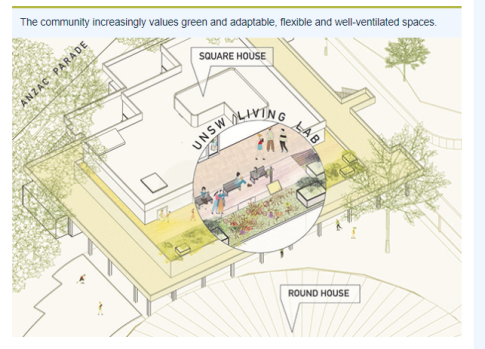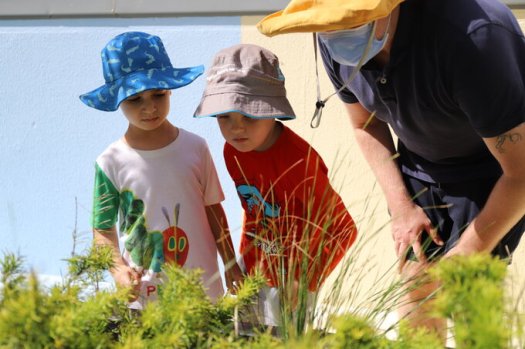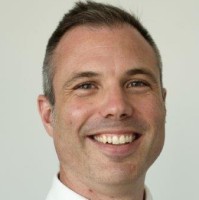Planning authorities need to focus on repurposing existing urban spaces rather than constructing new buildings if they want to create sustainable cities, a living cities expert says.

Alexander Georgouras from UNSW Arts, Design & Architecture has been working with Sydney councils to turn under-utilised spaces into functional rooftop gardens and green spaces.
Randwick City Council has partnered with Mr Geogrouras on a project to establish a SkyParks garden at UNSW, while Waverley Council has unveiled three SkyParks with shopping centre group Westfield.
Greening the City
SkyParks, funded under the NSW government Greening Our City initiative, involves establishing rooftop gardens in unloved spaces. As well as increasing urban greening, the SkyParks are contributing to learnings about how greening can contribute to cooling, save energy and improve air and water quality.
While investing in sustainable new buildings can help reduce emissions, Mr Georgouras says modifying existing buildings is a more effective way of creating efficient and sustainable cities.
He says the concept of the SkyPark came largely in response to urban density and the increase in people living in apartments.
It’s about trying to harness some of these more obscure unused urban spaces to provide what you could call the ‘missing middle’ of landscape amenity’
Alex Georgouras
“It’s about trying to harness some of these more obscure unused urban spaces to provide what you could call “the missing middle” for landscape amenity,” he tells Government News.
Mr Georgouras says SkyParks don’t have to be on public land, but they must be publicly accessible.
“A lot of our private landowners have been really onboard with creating these spaces and blurring the boundaries between public and private, and that’s what’s really ground breaking about what we’re doing,” he says.
He describes skygardens a “retrofit model applied to urban greening”.
“What we’re trying to put in the spotlight here is when we don’t have the resources or the appetite to completely knock down and rebuild, what can we do to transform the built environment to become more climactically adaptive?”
Living lab
UNSW is transforming a balcony in its Kensington campus into an inviting and adaptable space that can be used for learning, in what Mr Georgouras says is a coming together of university research and local government.
As part of the project the University has installed equipment to monitor weather and environmental conditions at the SkyPark to better understand the benefits of and requirements for greening built-up spaces.

Researchers hope it will provide quantifiable insights into the environmental, social and community benefits of rooftop gardens.
“The University is committed to attracting students back onto campus, and providing inviting and innovative learning environments can improve students learning experience, but also support their health and wellbeing,” Dean of Art, Design and Architecture, Clare Annesley says.
Randwick City Deputy Mayor, Kym Chapple, says Randwick hopes to apply the learnings from the campus project to new developments in the area.
“Ambitious projects to deliver significant carbon reductions need to happen sooner rather than later,” she says.
“Retrofitting existing exposed spaces in the built environment offers a huge opportunity for metropolitan councils and their communities to achieve sustainability and greening targets.”
Bush tucker garden
The Waverley LGA has a population of around 76,000 people and covers around only nine square-kilometres. At least 60 per cent of residents live in flats, units or apartments
In March, Council celebrated its first major environmental initiative for the year with the unveiling of bush tucker and coastal native gardens SkyParks gardens at Westfield Bondi Junction, and a pollinator garden on a rooftop car park.
The bush tucker and coastal native gardens are located near a child care centre and help children learn about climate systems and fresh food like native violets, finger limes and warrigal greens.

“They’re harvesting the bush tucker that’s grown there and starting to make some of their lunches with what they’ve harvested,” Mr Georgouras says.
Waverley Mayor Paula Masselos says lack of vegetation in parts of the Bondi Junction CBD make the area extremely hot during summer, with temperatures likely to increase further thanks to climate change.
“With limited ground-level space available to establish new parks or canopy, capturing opportunities to grow plants on top of built structures such as at Westfield is increasingly important,” she says.
“SkyParks is investigating the benefits and performance of different vegetated surfaces, to devise transferable and cost-effective ways to cool dense urban spaces and integrate more greenery into the built environment.
“It has potential benefits for other Sydney councils as we discover ways to adapt and transfer these learnings to other parts of the city and their communities.”
Knowledge networks
Mr Georgoras says working with local government on the projects has demonstrated the benefits of sharing knowledge within the local council network.
“There’s a lot of knowledge sharing that goes on within local council,” he says. “Randwick reached out to Waverly and said ‘we’d like to do something similar in our LGA’ and we were delighted to extend the skyPark network. We really hope it’s something we can grow.”

As part of his ongoing research Mr Georgouras is looking at establishing networks and protocols for ‘above grade greening’.
“At the moment the Sydney Green Grid deals with parks and transport corridors on the ground,” he says.
“But there hasn’t been a strategic plan for how to actually green our top spaces and look at things like pollination corridors and urban cooling rooftop greening.”
NSW DPE executive Director of Green & Resilient Places, Steve Hartley, says SkyParks is part of a wider suite of work to increase tree canopy cover across Greater Sydney.
“We are pleased to support and fund innovative projects like SkyParks which focus on creative, collaborative, and real-world solutions to help with greening our city,” he says.
“Greening car parks and other traditionally not-so-green spaces is something that can easily be scaled up across the city and beyond.”





Leave a Reply